|
|
| |
History
of
ST. PETER'S CHURCH, Clarksboro NJ
formerly of Berkley |
St.
Peter's Protestant Episcopal Church
304
Kings Highway
Clarksboro, NJ 08028
(856) 423-4116
FAX: (856) 423-4938
Website:
www.stpetersclarksboro.org
Map
and Directions
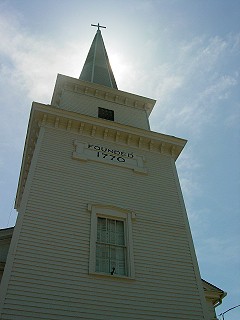
St.
Peter's Episcopal Church -- Clarksboro, NJ
Photographs by Janice Brown in
2003 & 2004
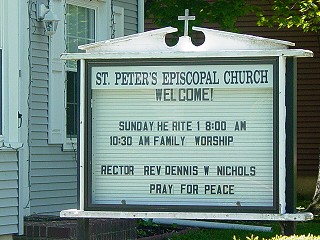
St.
Peter's Episcopal Church was founded at Berkeley [now Mount
Royal]. The original 1770 deed for the land at Berkley clearly states that
"the said half acres of ground...for the use of an English Church to be
built and Burying Ground."
In 1765 the first Episcopal church
service was held in a private home in Mt. Royal. Residents continued to receive
visits from Nathaniel
Evans, an ordained Episocopal deacon and poet, who "as opportunity permitted,
visited and preached on week days in several parts of the county, wherever a few
church families had settled...(including) Mantua Creek." This preaching was
typical held in private dwellings if no church structure had been built. [Rev.
Evans wrote a
poem about Benjamin Franklin, after hearing him play the hamonica].
When Nathaniel Evans died in 1767, well-kept diaries of Dr.
Nicholas Collin, Bishop Asbury and the Rev. Joseph Pilmore state that Methodists
preached in the new church. From 1767 to November of 1770 there was no missionary
to take Evan's place.
As odd as this sounds to us now, years ago this
occurred frequently in our area. Pulpits became vacant for many reasons, and replacements
would very often be several years arriving to take charge. During times when the
churches were without ministers, its parishioners would willingly accept the services
of another clergyman, regardless of demonination.
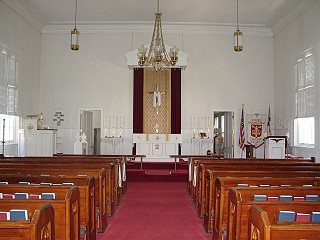 Inside St. Peter's
Church
Inside St. Peter's
Church
Photographs taken by Janice Brown, May 2004 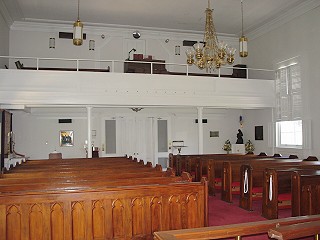
|
It is probably
that following the death of Nathaniel Evans, his father, Edward Evans, (an early
Methodist) took up his son's congregations in New Jersey. Joseph
Pilmore wrote of him, "He frequently went into the Jerseys to preach,
and as the people were exceedingly fond of him, built a pretty little chapel,
and insisted on having him for their minister (October 1771)."
This
church property was located on Mantua Creek, at what is now called Mount Royal,
and probably at the same location as the current old
St. Peter's cemetery. On November 29, 1770 a half acre lot was deeded by Uriah
Paul to Edward Evans of Philadelphia and eleven other "managers," Evans
being named first. When Edward Evans died less than two years later in 1771, Pilmore
preached his funeral sermon in a chapel there at the "request of the heads
of the congregation."
Reverend David Griffith followed Evans, but
remained only a short time. From April 1771 until November 1773 the mission was
once again without a missionary.
Francis
Asbury, who had come to America at the request of John Wesley to aid in the
work of Methodism, and who later became the first American Bishop of the Methodist
Episcopal Church, arrived in Philadelphia in1771. From his journal we know that
he preached at this church in Berkley.
On November 20, 1773 Robert Blackwell
was appointed by the Bishop of London to Gloucester County to fill the vacancy
caused by the removal of David Griffith in 1771. On April 7, 1774 the congregation
of Greenwich (now East Greenwich) appointed Rev. Blackwell a manager to fill the
vacancy left since the death of Edward Evans in 1771.
On June 30, 1774, a regular meeting was held by appointment of the Greenwich
Church managers and several regulations agreed upon, including: that it was
the intent that the land and premises were for the use of the contributors whose
names were entered in 'The Greenwich Church Book'; that by far the greater part
of the monies laid out in said building were given by persons who professed themselves
members of the Church of England; that from this day forward no person shall preach
in this House but the Clergy of the Church of England, unless he first obtain
leave under the hand of Dr. Botto Otto, Jr.; any person dissatisfied with this
resolve may have his money back by applying to Thomas Clark, Esquire. This
document was signed by Robert Blackwell, along with managers and clerks as follows:
Timothy Clark, Isaac Inskeep, Thomas Thomson, Samuel Tonkin, Jonathan Chew, Gabriel
D. Viber and Botto Otto, Jr. Mr. Joshua Paul and
Mr. Jeffrey Chew, being present, agreed that the above resolves were right and
just and they declined to serve any longer as managers of said Church. Dr. Bodo
Otto and Gabriel D. Viber were chosen in their stead before the signing of these
resolves.
A meeting held in September of 1775 increased the stringency
of the above resolutions. This action caused a split in the congregation, part
of the people going back to the ways of the Episcopalian and the rest to the new
Evangel Faith (or Methodism), which had held class meetings, organized, and had
built the church for Mr. Edward Evans.
From a handwritten document
in the possession of St. Peter's Church: "The foundations for the old church
at Berkeley were laid as early as 1765. There is unfortunately no drawing or sketch
of the Church in existence. The Rev. J.Y. Burk in one of his papers speaks of
Mr. Clark when he was 83 years of age with his recollection of the Church, 'as
keen as if he had just seen it the day before.' He said it was thoroughly well
built, of a substantial frame structure about forty-five feet square with a hipped
roof and stood on the old burial ground at Berkeley about seventy-five feet from
the turnpike and there were stairways both right and left leading up to the gallery.
A broad middle aisle ran from the door to the Chancel. The pulpit was the old
fashioned kind called the three decker, consisting of one piece of furniture divided
into three parts, a communion table at the bottom, over that a reading desk and
over that the pulpit. The latter two reached by winding stairs. This form of pulpit
can still be seen at Gloria
Dei Church in Philadelphia or the old Moravian Church at Oldman's Creek near
Swedesboro. The Church was not plastered, but the interior walls and ceiling were
formed of neatly fitted boards painted white. The building was heated by a great
ten plate stove."
In 1824 Reverend Richard D. Hall, was
the regular minister in charge. He also served St. Mary's in Colestown, formed
St. Stephen's in Mullica Hill, and also served at St. John's at Chew's Landing.
Following Rev. Hall, Rev. William Bryant became rector for one year. Then Rev.
Simon Wilmer of Pennsylvania was chosen (he was silenced in 1834 by Bishop Doane).
Rev. Hiram Harrold (formerly a Methodist minister who became an Episcoplian) became
rector in 1836
At a meeting on December 17, 1838 a resolution
was adopted to purchase the house and premises that were occupied then by Rev.
Mr. Harrold in Clarksboro to be occupied as a parsonage for the church.
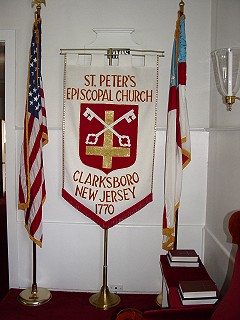 Inside St. Peter's
Church, Clarksboro
Inside St. Peter's
Church, Clarksboro
Photographs by Janice Brown May 2004 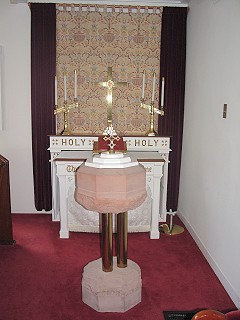
|
At
a special meeting of the congregation held Nov. 18, 1845, the matter of building
a new church was considered. The church's site was moved to Clarksboro,
and the stones from the original church were used for
the cemetery walls that still surround the old church yard in Mount Royal
on King's Highway. Bishop
George Washington Doane dedicated the new (present) church. This new church
was built near the junction of Cohawkin Rd. and Kings Highway in 1845 and dedicated
on Dec 17, 1846.
The complete list of clergymen of St. Peter's Episcopal
Church is:
Rev. Robert Blackwell, D.D., Rev. Richard D. Hall, Rev. William
Bryant, Rev. Simon Wilmer, Rev. Hiram Harrold, Rev. Samuel C.
Stratton, Rev. Archibald Beatty, Rev. Henry B. Barton, Rev. Isaac
W. Hallam, Rev. Francis E.R. Chubbuck, Rev. James Hart Lamb, Rev.
Jesse Y. Burk, Rev. J.H. O'Brien, Rev. D.W. Wells, Rev. T.L. Josephs,
Rev. W.W. Williams, Rev. Lewis Chester Morrison, James F. Adams
(Seminarian in charge), William J. Marvin (Seminarian in charge),
Rev. Edward R. Cook, Rev. Gerald A. Reiss, and Rev. Dennis W.
Nichols (who left in 2013).
The exterior of St. Peter's Episcopal Church can best be described as "New
England Colonial."
SEE "Events at St.
Peter's Church" | |

